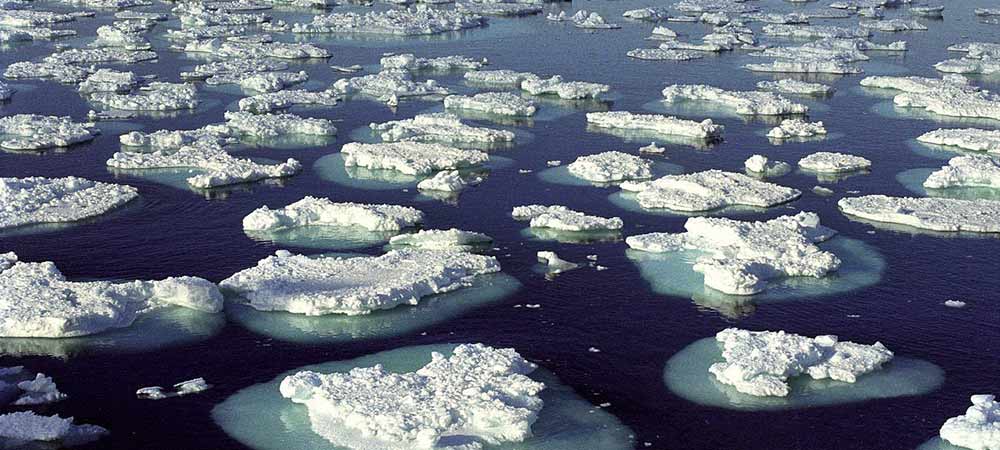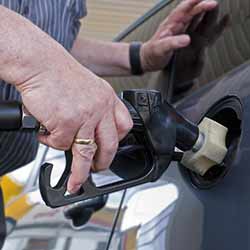
Dear EarthTalk: To what extent is Antarctica really melting and what impact might it have on coastlines around the world? — Andrea Hutchinson, Cary, NC
The Antarctic continent, roughly the size of the United States and Mexico combined, is composed of rock covered by glaciers some 16,000 feet thick. The glaciers form from fallen snow compacting into successive layers of ice, and they eventually move downhill toward the coasts and “calve” into the ocean as icebergs and eventually melt out into the sea. Antarctica and Greenland combined hold about 99 percent of the globe’s freshwater ice.
According to the National Snow & Ice Data Center, the result of the entire Antarctic continent melting out completely would be sea level rise of about 200 feet around the world, which could, in turn, lead to untold devastation. While no one can be sure how hot things will get as a result of global warming, most climate models don’t forecast conditions hot enough to cause the wholesale melt-out of Antarctica.
In fact, the British Antarctic Survey (BAS) reports that the East Antarctic Ice Sheet, which constitutes about two-thirds of the world’s southernmost and iciest continent, is remaining relatively stable, with some slight melting that is balanced out by new winter snows. Because East Antarctica rests on rock that is higher than sea level, it is unlikely to collapse. In fact, East Antarctica’s ice cover may thicken moving forward due to predicted increases in snowfall amounts over the coming decades.
But on the west side of Antarctica, ice across an area roughly the size of Texas called the Amundsen Sea Embayment (ASE) is already thinning rapidly in large part as a result of surrounding waters warming up due to changing ocean circulation patterns. Many scientists believe that these ocean changes are happening as a result of human-induced global warming as well as thinning of the stratospheric ozone layer.
“This is an area that has always caused glaciologists concern, because here the bedrock beneath the ice is a long way below sea-level and the ice is only kept in place because it is thick enough to rest on the bed,” reports BAS. “Thinning of the ice around the coast could lead to glacier acceleration and further thinning of the ice sheet. Essentially, the ice sheet may be unstable, and the recent pattern of thinning could be a precursor to wholesale loss of the ASE ice sheet.”
Meanwhile, researchers from NASA and UC Irvine studying the ASE ice sheet report a “continuous and rapid retreat” of glaciers there and think that there is “no [major] obstacle that would prevent the glaciers from further retreat.” They worry that within a millennium and perhaps as soon as two centuries, the ASE could melt out entirely — leading to between four and 10 feet of sea level rise around the world — if moderate warming models prove to be correct.
Of course, we can all play a role in preventing such scenarios by reducing our carbon footprints. Take fewer airplane trips. Buy organic food. Walk, bike or take public transit to work. If you must drive, get a hybrid or electric car. Wear a sweater instead of turning up the heat. And urge legislators to push new laws that limit greenhouse gas emissions by industry, utilities and other big polluters. It may be now or never.
CONTACTS: National Snow & Ice Data Center, nsidc.org; British Antarctic Survey, www.antarctica.ac.uk.
Dear EarthTalk: I thought that putting ethanol in our gas tanks was going help fight climate change, but lately I’ve heard reports to the contrary. Can you enlighten? — Bill B., Hershey, PA
 Ethanol and similar “biofuels” made from corn and other crops seem like a good idea given their potential for reducing our carbon outputs as well as our reliance on fossil fuels. But recent research has shown that the federal government’s push to up production of corn-derived ethanol as a gasoline additive since 2007 has actually expanded our national carbon footprint and contributed to a range of other problems.
Ethanol and similar “biofuels” made from corn and other crops seem like a good idea given their potential for reducing our carbon outputs as well as our reliance on fossil fuels. But recent research has shown that the federal government’s push to up production of corn-derived ethanol as a gasoline additive since 2007 has actually expanded our national carbon footprint and contributed to a range of other problems.
U.S. corn producers started ramping up ethanol production in 2007 as a result of President George W. Bush’s Renewable Fuels Standard (RFS), which mandated an increase in the volume of renewable fuel to be blended into transportation fuel from nine billion gallons in 2008 to 36 billion by 2022. Ethanol now makes up 10 percent of the gasoline available at filling stations.
But environmentalists now say that the promise of ethanol has turned out to be too good to be true. For one, there is the issue of net energy produced. According to Cornell University ecologist David Pimentel, growing and processing corn into a gallon of ethanol requires 131,000 BTUs of energy, but the resulting ethanol contains only 77,000 BTUs. And since fossil-fuel-powered equipment is used to plant, harvest, process and distribute ethanol, the numbers only get worse.
The non-profit Environmental Working Group (EWG) warns that continued production of corn ethanol is not only “worse for the climate than gasoline” but also bad for farmers, the land and consumers: “It is now clear that the federal corn ethanol mandate has driven up food prices, strained agricultural markets, increased competition for arable land and promoted conversion of uncultivated land to grow crops.”
Additionally, the group reports that previous estimates “dramatically underestimated corn ethanol’s greenhouse gas emissions by failing to account for changes in land use,” citing a 2012 study documenting the conversion of eight million acres of Midwestern grassland and wetlands to corn fields for ethanol between 2008 and 2011. “These land use changes resulted in annual emissions of 85 million to 236 million metric tons of greenhouse gases,” says EWG. “In light of these emissions, many scientists now question the environmental benefit of so-called biofuels produced by converting food crops.”
Given the potential negative impacts of so-much corn-based ethanol, the U.S. Environmental Protection Agency is reportedly weighing a proposal to cut the amount currently required by law to be blended into gasoline by 1.39 billion gallons. If the federal government decides to do this, it could lower U.S. carbon emissions by some three million tons — equivalent to taking 580,000 cars off the roads for a year.
Meanwhile, researchers are trying to develop greener forms of ethanol, but none are ready for market yet. “The lifecycle emissions of ethanol ‘from seed to tailpipe’ depend on how the ethanol is made and what it is made from,” reports the Union of Concerned Scientists (UCS). The best ethanol, they say, can produce as much as 90 percent fewer lifecycle emissions than gasoline, but the worst can produce much more. So there still may be room for ethanol in our energy future, but not if we keep doing it the way we are now.
CONTACTS: Renewable Fuel Standard, www.epa.gov/otaq/fuels/renewablefuels; David Pimentel, vivo.cornell.edu/display/individual5774; EWG, www.ewg.org; UCS, www.ucsusa.org.
Dear EarthTalk: How is it that migrating birds are being negatively affected by oil extraction in Canada’s Boreal forest? — Jennifer Chase, Fort Lauderdale, FL
 Each year tens of millions of migratory birds “overwinter” in the Canadian Boreal forest, a vast tract of mostly uninhabited coniferous woodlands and wetlands stretching from Newfoundland to the Yukon. The area makes up some 60 percent of Canada’s total land mass, and serves as the winter home for more than half of America’s avian population. But environmentalists are worried about the impact of increasing “tar sands” oil development there and the impact it might have on wildlife populations continent-wide.
Each year tens of millions of migratory birds “overwinter” in the Canadian Boreal forest, a vast tract of mostly uninhabited coniferous woodlands and wetlands stretching from Newfoundland to the Yukon. The area makes up some 60 percent of Canada’s total land mass, and serves as the winter home for more than half of America’s avian population. But environmentalists are worried about the impact of increasing “tar sands” oil development there and the impact it might have on wildlife populations continent-wide.
Tar sands are a mixture of sand, clay, water and a dense and viscous tar-like form of petroleum called bitumen. The bitumen is extracted from the tar sands mixture and eventually refined into transportation fuel like gasoline. The extraction process is especially “carbon-intensive” and generates some of the dirtiest fuel around, but its abundance makes it affordable as long as industry keeps turning up new sources.
A recently released report by the National Wildlife Federation (NWF) and the Natural Resources Council of Maine (NRCM) concluded that almost half of the 292 different migratory bird species that overwinter in Canada’s Boreal forest — as many as 75 million birds — are threatened by future tar sands development. Further, they say, bird losses in the hundreds of thousands have already taken place as a result of overzealous and under-regulated oil development there to date.
“The direct and indirect impacts to birds from tar sands development are immense,” states the report. “Waterfowl and shorebirds land in tailings ponds that they mistake for natural water bodies and become oiled with waste bitumen and toxic elements.” The result can be birds drowning, dying from hypothermia or otherwise suffering from the ingestion of toxins. “Toxins from the tailings ponds and other pollutants from tar sands operations leak millions of gallons of toxic liquid waste into wetlands and forests each day, further contaminating habitat,” the groups add.
Tar sands development also contributes disproportionately to climate change. U.S. State Department analysis shows that tar sands oil is 20 percent more carbon pollution intensive than conventional oil on a “well-to-wheel” basis. The effects of global warming on Canada’s Boreal forest are likely to include shifting food supplies, increasing numbers of damaging wildfires in forests, more droughts in wetlands and potentially dramatic changes in vegetation and the relationships between predators and prey.
Environmentalists would like to see U.S. lawmakers deny permits for the transport of Canadian Boreal tar sands oil — most of which is extracted in land-locked regions — through the U.S. in hopes of making future tar sands projects there too expensive to be worthwhile.
“Saying no to tar sands is a critical pillar in an effective strategy to protect wildlife from carbon pollution,” says NWF. Furthermore, given Americans’ growing desire to get away from costly and polluting foreign oil, it makes sense to pass on adding dirty tar sands oil to the mix. But it remains to be seen if the Obama administration will allow construction of the controversial Keystone XL pipeline to transport the oil from Canada through the U.S. The welfare of millions of birds — and, indeed, our energy future — is at stake.
CONTACTS: NWF, www.nwf.org; NRCM, www.nrcm.org.
Dear EarthTalk: We must really be swimming in electronic waste, what with all the iPhones and other devices that are so common. How is this all being dealt with? — Mary Shufelt, New Bern, NC
 With electronic equipment and gadgets the fastest-growing waste stream in many countries, how to deal with so-called “e-waste” may, in fact, be one of the most pressing environmental problems of the 21st century. According to BCC Research, consumers around the world purchased 238.5 million TVs, 444.4 million computers and tablets and a whopping 1.75 billion mobile phones in 2012 alone. Most of us discard such items within three years of purchase, and this is driving the global growth in e-waste by some eight percent a year. Meanwhile, a recent study conducted by researchers from the Massachusetts Institute of Technology (MIT) on behalf of the United Nations found that the growth in demand for and manufacturing of new electronics will result in a 33 percent increase in e-waste globally between 2012 and 2017.
With electronic equipment and gadgets the fastest-growing waste stream in many countries, how to deal with so-called “e-waste” may, in fact, be one of the most pressing environmental problems of the 21st century. According to BCC Research, consumers around the world purchased 238.5 million TVs, 444.4 million computers and tablets and a whopping 1.75 billion mobile phones in 2012 alone. Most of us discard such items within three years of purchase, and this is driving the global growth in e-waste by some eight percent a year. Meanwhile, a recent study conducted by researchers from the Massachusetts Institute of Technology (MIT) on behalf of the United Nations found that the growth in demand for and manufacturing of new electronics will result in a 33 percent increase in e-waste globally between 2012 and 2017.
But why is e-waste any more of a problem than old fashioned garbage? “Some of the materials in personal electronics, such as lead, mercury and cadmium, are hazardous and can release dangerous toxins into our air and water when burned or deposited in landfills improperly,” reports the non-profit Natural Resources Defense Council (NRDC). “And throwing away metal components, like the copper, gold, silver and palladium in cell phones and other electronics, leads to needless mining for new metals.”
Today some 80 percent of unwanted electronics are disposed of improperly. “E-waste is either discarded or exported to emerging nations, where open-air burning and acid baths are used to reclaim precious metals and other elements,” reports Maureen O’Donnell in EHS Journal. The lack of proper controls in such countries, she says, has led to elevated lead levels in children and heavy metals pollution of soil and water. As a result, she adds, “we now stand at the forefront of a growing environmental catastrophe.”
The good news is that many nations have enacted new laws to hold manufacturers responsible for the future e-waste created by their products. The European Union has led the way with its Waste Electrical and Electronic Equipment (WEEE) Directive, which calls on electronics makers to “take back” their products for recycling when consumers upgrade to something new, and restricts European countries from exporting or importing e-waste. Japan and China are among other countries that have passed similar laws.
The U.S. government has yet to follow suit, but the Electronics Takeback Coalition (ETC) reports that 21 U.S. states have implemented their own “take back” laws, and several other states are considering similar legislation. Meanwhile, environmentalists continue to pressure Congress to consider similar legislation at the national level, given especially that Americans are the world leaders in generating e-waste.
Additionally, many manufacturers are adopting voluntary e-waste recycling certification standards. One is the e-Stewards program, which helps those looking to dispose of obsolete electronics identify recycling options that adhere to high standards of environmental responsibility and worker protection. Another program, R2 Certification, run by the non-profit SERI, is supported by several large manufacturers, including DirecTV and Microsoft. Consumers can do their parts by choosing manufacturers that embrace so-called “producer pays” electronics recycling through participation in one of these programs.
CONTACTS: ETC, www.electronicstakeback.com; e-Stewards, www.e-stewards.org; SERI, www.sustainableelectronics.org; WEEE, http://ec.europa.eu/environment/waste/weee/legis_en.htm.
Dear EarthTalk: Is it true that much of our food — including cereals and snacks eaten by children — is actually over-fortified with excessive amounts of vitamins and minerals that can be dangerous to our health? — Diane Summerton, Waukesha, WI
 Added nutrients in the processed foods we eat could indeed be too much of a good thing, especially for kids. According to a report from non-profit health research and advocacy group Environmental Working Group (EWG), nearly half of American kids aged eight and under “consume potentially harmful amounts of vitamin A, zinc and niacin because of excessive food fortification, outdated nutritional labeling rules and misleading marketing tactics used by food manufacturers.” EWG’s analysis for the “How Much Is Too Much?” report focused on two frequently fortified food categories: breakfast cereals and snack bars.
Added nutrients in the processed foods we eat could indeed be too much of a good thing, especially for kids. According to a report from non-profit health research and advocacy group Environmental Working Group (EWG), nearly half of American kids aged eight and under “consume potentially harmful amounts of vitamin A, zinc and niacin because of excessive food fortification, outdated nutritional labeling rules and misleading marketing tactics used by food manufacturers.” EWG’s analysis for the “How Much Is Too Much?” report focused on two frequently fortified food categories: breakfast cereals and snack bars.
Of the 1,550 common cereals studied by EWG, 114 (including Total Raisin Bran, Wheaties Fuel, Cocoa Krispies, Krave and others) were fortified with 30 percent or more of the adult Daily Value for vitamin A, zinc and/or niacin. And 27 of 1,000 brands of snack bars studied (including Balance, Kind and Marathon bars) were fortified with 50 percent or more of the adult Daily Value for at least one of these nutrients. EWG researchers based their analysis on Nutrition Facts labels on the various food items’ packaging.
“Heavily fortified foods may sound like a good thing, but when it comes to children and pregnant women, excessive exposure to high nutrient levels could actually cause short or long-term health problems,” says EWG research director Renee Sharp, who co-authored the report. “Manufacturers use vitamin and mineral fortification to sell their products, adding amounts in excess of what people need and more than might be prudent for young children to consume.”
Sharp adds that excessive levels of vitamin A can lead to skeletal abnormalities, liver damage and hair loss, while high doses of zinc can impede copper absorption, compromise red and white blood cells and impair immune function. Also, too much vitamin A during pregnancy can lead to fetal developmental issues. And older adults who get too much vitamin A are at more risk for osteoporosis and hip fractures.
EWG suggests it’s time to overhaul our food labeling system to better account for how ingredients may affect children as well as adults. “In other words, when a parent picks up a box of cereal and sees that one serving provides 50 percent of the Daily Value for vitamin A, he or she may think that it provides 50 percent of a child’s recommended intake,” says EWG researcher and report co-author Olga Naidenko. “But he or she would most likely be wrong, since the Daily Values are based on an adult’s dietary needs.”
EWG is working on the U.S. Food and Drug Administration (FDA) to update its guidelines for Nutrition Facts to better reflect how foods affect children as well as adults. In the meantime, parents might want to consider scaling back on fortified foods for their kids in favor of so-called whole foods (unprocessed, unrefined fruits, vegetables and whole grains) that deliver the right amounts of nutrients naturally.
“Research consistently shows that the nutrient amounts and types found in whole foods provide optimal nutrition as well as least risk,” says Ashley Koff, a registered dietitian and a former ad executive for kid’s cereals and snack bars. “We owe it to parents and kids to make it easiest to choose better quality foods.”
CONTACT: EWG’s “How Much Is Too Much?” report, www.ewg.org/research/how-much-is-too-much.












